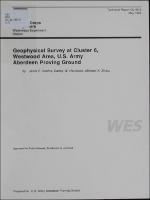Please use this identifier to cite or link to this item:
https://hdl.handle.net/11681/12771Full metadata record
| DC Field | Value | Language |
|---|---|---|
| dc.contributor | Aberdeen Proving Ground (Md.). Directorate of Safety, Health, and Environment | - |
| dc.contributor.author | Simms, Janet E. | - |
| dc.contributor.author | Harrelson, Danny W. | - |
| dc.contributor.author | Sharp, Michael K. | - |
| dc.date.accessioned | 2016-07-06T14:27:55Z | - |
| dc.date.available | 2016-07-06T14:27:55Z | - |
| dc.date.issued | 1995-05 | - |
| dc.identifier.uri | http://hdl.handle.net/11681/12771 | - |
| dc.description | Technical Report | - |
| dc.description | Abstract: A geophysical investigation was conducted at Cluster 6 Site 5, located in Westwood Area of the U.S. Army Aberdeen Proving Ground. This site is the former Westwood Area Radioactive Material Disposal Facility (WRMDF) which was used for processing and packaging radioactive waste material prior to disposal. Original structures at the site included Building 3013 and adjacent concrete slabs where the waste handling work was performed, a small equipment shed, and a wastewater holding and drain system which included tanks in a concrete pit. Discharge of wastewater from the tanks was to Reardon Inlet, located a short distance south of the tank pit. Possible release of radioactive waste to the environment would have been due to either spillage, leakage, or discharge from the wastewater system. Two terra cotta pipelines, one on the western end and one of the eastern end, extended from Building 3013 to Reardon Inlet. The east pipeline handled low-level radioactive wastewater. The west pipeline was the original wastewater line and it is presumed that radioactive wastewater was not discharged through this line. After radioactive waste handling activities were discontinued at WRMDF, the west pipeline system was upgraded to include a septic tank, sand filter bed, and a chlorine contact chamber. The suuctures associated with the WRMDF were removed during the early 1970's, including the concrete tank pit. Both pipelines are visible near the edge of Reardon Inlet, suggesting that the pipes and related structures have not been removed. Geophysical surveys including magnetics, electromagnetics (EM), and ground penetrating radar, were performed to identify the location of the two terra cotta pipes, septic tank, and sand filter bed. A large anomaly was evident in the magnetic and EM data collected over the western pipe area, and may be due to the septic tank. A linear conductivity anomaly which extended from south of the suspected septic tank location to Reardon Inlet was detected. This anomaly is not believed to correspond to the location of a pipeline since it is directed away from the suspected location of the pipe. None of the methods gave a positive indication of the location of either terra cotta pipeline. | - |
| dc.publisher | Geotechnical Laboratory (U.S.) | - |
| dc.publisher | Engineer Research and Development Center (U.S.) | - |
| dc.relation | http://acwc.sdp.sirsi.net/client/en_US/search/asset/1028504 | - |
| dc.relation.ispartofseries | Technical report (U.S. Army Engineer Waterways Experiment Station) ; GL-95-5. | - |
| dc.rights | Approved for public release; distribution is unlimited. | - |
| dc.source | This Digital Resource was created from scans of the Print Resource | - |
| dc.subject | Electromagnetics | - |
| dc.subject | Geophysical survey | - |
| dc.subject | Geophysical exploration | - |
| dc.subject | Geophysics | - |
| dc.subject | Ground penetrating radar | - |
| dc.subject | Magnetics | - |
| dc.subject | Radioactive waste sites | - |
| dc.subject | Water | - |
| dc.subject | Water pollution | - |
| dc.subject | Aberdeen Proving Ground (Md.) | - |
| dc.title | Geophysical survey at Cluster 6, Westwood Area, U.S. Army Aberdeen Proving Ground | - |
| dc.type | Report | en_US |
| Appears in Collections: | Technical Report | |
Files in This Item:
| File | Description | Size | Format | |
|---|---|---|---|---|
| TR-GL-95-5.pdf | 6.31 MB | Adobe PDF |  View/Open |